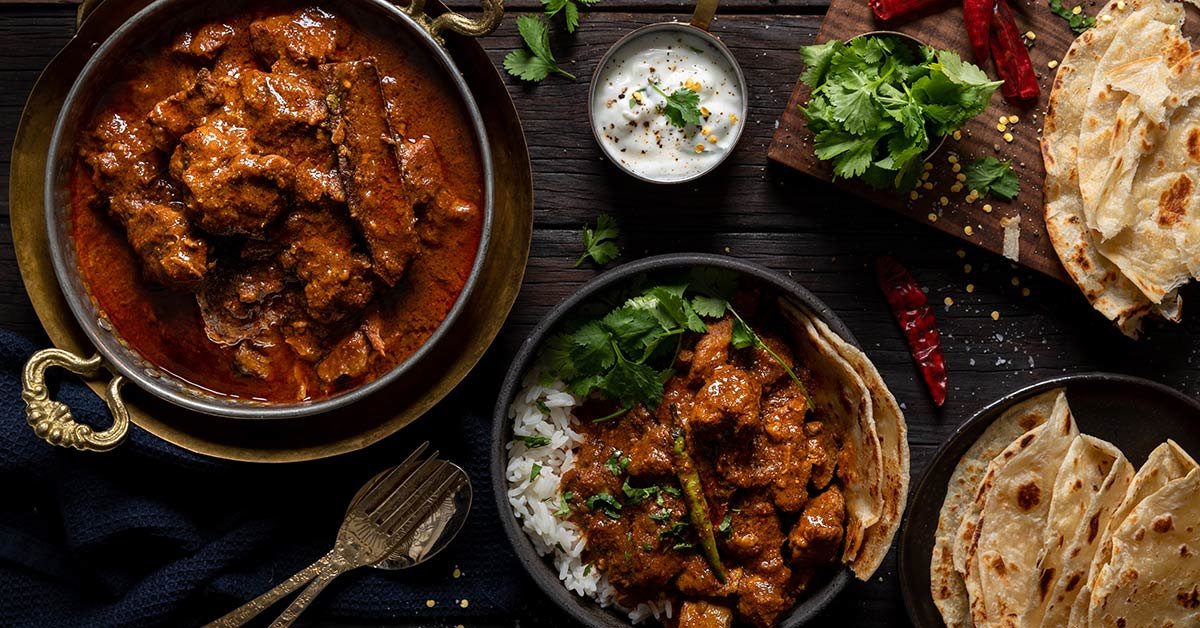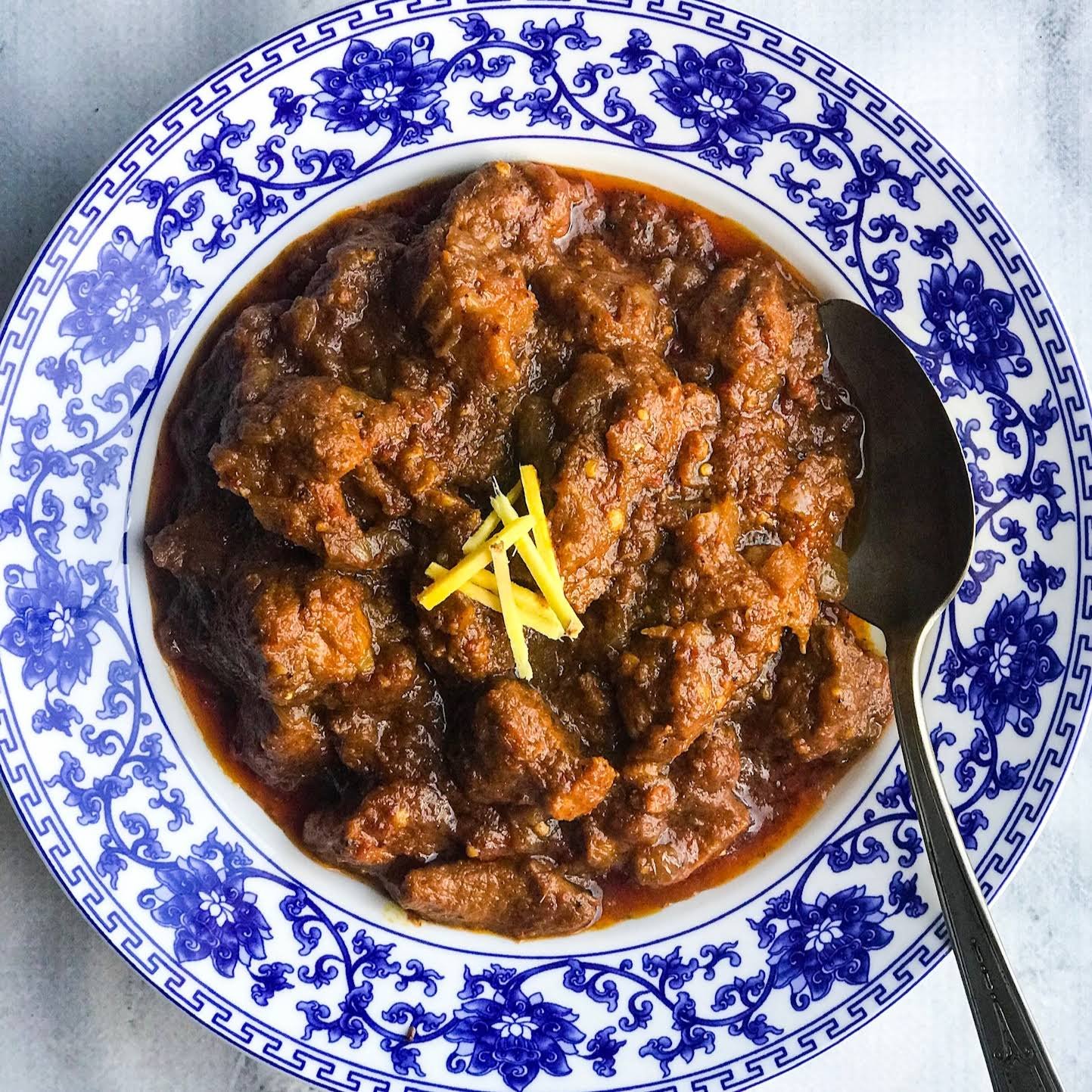Vindaloo: One Curry’s 500-Year Resistance

Caught between Portuguese colonists and the arrival of the East India Company, Goa’s vindaloo is a curry mottled by its colonists. But it is also one that Goa has made its own. Following six long centuries, Deepshika Paspunuri finds that vindaloo is the story of change, assimilation, and colonisation in a small coastal colony.
Coming off a brutal sea route, ships carrying sailors, soldiers, missionaries, and traders came into Estado da Índia, or Portuguese India. Supporting this crew wasn’t easy, especially if you were the ship’s cook. With a scarce pantry, stocked only by provisions that could outlast the three-month journey, they cobbled together a sailor’s stew called ‘carne de vinha d’alhos’. More than 500 years later, this dish, and its muddled pronunciation, would come to be known as the Goan vindaloo.
1500s: The Fall of Vinegar
Originally a simple three-ingredient recipe, carne de vinha d’alhos was made with dry pork, marinated in wine vinegar with garlic and shallots. However, when its preparation moved into India’s domestic hands, its cooks, housewives, kitchen staff, and imperial servants would all take a stab at the dish.
Following the conquest of Goa in 1510, the Portuguese quickly realised that their new colony couldn’t exactly replicate their stew. This was because India, at the time, had no vinegar. Something had to be done. Desperate for a new marinade, a few clever Franciscan priests turned to the palm wine fermented from native coconut sap. Cooked with a slew of garlic, this new base, much to their delight, tasted pretty close to the original.
This isn’t the case today, of course. Known for its bright acidic twang, vindaloo is nothing like a stew; instead it is a sought-after vermillion-red Goan curry. More importantly, it is a far cry from the humble sailor’s dish that washed ashore five centuries ago. So, what happened?
Chilli: An Unexpected Coup
There is context to this dramatic ‘Indianisation:’ Months before setting sights on India, the Portuguese empire was shipping loot from Latin America across the seas. The region hadn’t only made them wealthy; it had brandished their tongues — a surprising love for the continent's red chillies.
When these ships finally landed in India, it launched a coup on the country’s kitchens. Before Portugal’s arrival, black pepper was the hottest-known spice. But because these imported chillies were easy-growing, cheap, and tasted similar to long pepper, they quickly gained popularity and became integral to the subcontinent’s cuisine. Chilli wasn’t the only new import either. Many new foods, like potatoes, tomatoes, and corn, arrived as part of the Columbian Food Exchange, arming already-loaded Goan kitchens with a unique multicultural pantry. Portugal’s stew, made in such cookhouses, was no exception either.
Eventually, more native ingredients, including cinnamon, cardamom, tamarind, and black pepper — like small acts of resistance — also started making their way into the recipe. Combined with ground spices and traditional vessels manned by locals, Portugal's sovereignty over the stew continued to diminish. So much so that by the time Britain occupied India around 1797, the dish they discovered was less like something cobbled out of a ship crew’s rations; but rather a brilliant display of East-meets-West.
How Vindaloo Became Britain’s Searing Immigrant
Vindaloo’s introduction to Britain was also made in the hands of Christian Goan cooks — a class that arose directly from Portuguese rule. As a by-product of mass conversions, beef and pork had entered local kitchens for the first time. Since these were dishes loved in Britain, yet hardly made in India because of caste and religious restrictions, such cooks became a sought-after workforce during the 1800s.
Moreover, British expats were mostly single men. This meant someone had to run their kitchens, stock cabinets, plan three daily meals, buy ingredients and most of all, actually cook them. Because of this dependence, colonial food wasn’t solely a one-way street; but a site where power and identity could be actively negotiated, especially by Goan cooks.
Vindaloo | image credit Yummly
Over time, their vindaloo, so different from a gentlemen’s dinner, became one of the many curries that conquered the imperial dining table. It wasn’t just that these officers, troops, and company staff liked curry; it was also the complete crisis it caused in their household — from angry wives to clandestine binges, begrudging dismissals, and more bafflingly, actual praise. As one anonymous imperial officer’s wife admits in a rare surviving document: “In the end, we simply loved their curry. It was delicious.”
Such slippages — for an empire keen to deny cultures outside of England — became a growing testament to vindaloo, which now occupied an intimate place in the ruling classes’ diet. By the time the last British troops left India, curries like vindaloo became so naturalised that “few dinners are thought complete unless one is on the table.”
Vindaloo: A Dish Without A Country
Early colonial cookbooks, owing to this, maintained a surprising authenticity to the Goan original. Wife’s Help to Indian Cookery, published in 1888, shows just how ‘Indian’ its preparation was at the time, listing ingredients like ghee, a half-dozen cinnamon and cardamom sticks, mustard oil, tej-path, and even a whopping two teaspoons of chilli. But when Britain imported the dish into the UK during the 1970s, a time when Indian restaurants were gaining popularity, it simply became ‘the spiciest curry on the menu’. The tang of vinegar, pickled meat, and the balancing act of different spices was lost to a scorching excess of chillies.
Dubbed a ‘lad’s curry’, vindaloo became synonymous with displays of bravado. A 1998 football anthem even features the dish in its excruciating chorus — “Vindaloo Vindaloo. And we all like Vindaloo. We're England. We're gonna score one more than you” — shouting out the curry no fewer than fifteen times.
The song’s unplanned success — a top two spot on the UK Singles Chart — also came as a surprise to Fat Les, the creator trio behind it, who described it as a parody they thought sounded “stupid enough to be memorable.” Equally interesting, however, is its payoff, which rallied modern match-goers to celebrate a defiantly Indian curry in lieu of ‘Englishness’.
The irony that this was the very idea the empire sought to preserve isn’t lost on Allen either, the song’s co-writer, who now jokes: “Getting a load of reactionary fuckers to sing ‘Vin-da-loo’ was actually quite hilarious.”
Back in India, Britain’s high-heat preparation is regarded as a corrupt version. “The right amount of spices should be added,” warns Roystern D’Souza, “otherwise it overpowers the dish.” His father, Patrick D’Souza, owns Bhatti Village Restaurant, a family-run establishment known to produce some of the most authentic Goan food. It is located in Nerul, a coastal town in north Goa, far from prying tourists. In fact, Patrick was so protective about their dishes that till recently, Bhatti Village didn’t even have a menu.
Patrick and his son agree that balance is important in any vindaloo. Measuring ingredients isn’t what achieves this though as Roystern quickly tells me, “Weighing scale at Bhatti’s is a complete no; it's all in the experience and magic of the hands.”
This means it’s actually down to Patrick’s wife, Merciana D’Souza, who handles the kitchen at their award-winning restaurant. “I learned [how to make vindaloo] from my mother as well as Patrick,” she says. Curious about the recipe, I ask if the D’Souza family keeps theirs hidden from outsiders. But no, they’re actually happy to let us in.
“You know the ketchup and all? We don't do that. We do real, authentic Goan food," says Patrick. Roystern, too, cautions against tomato puree, not just once but twice. “There are no secrets in vindaloo,” he admits, just homemade coconut vinegar, a basic red masala, and no commercial sauces.
Like the D’Souzas, many Goan haunts, chefs, and seaside shacks also offer an authentic plate of vindaloo. But there are exceptions. For instance, ‘alhos', a word that meant garlic in Portuguese, was misunderstood as ‘aloo’, giving way to new vegetarian variations prepared with potatoes. Traditional cooks find this mortifying. But in a country with Muslims and vegetarian Hindus, it’s hard to say that this pork substitute is misplaced. In fact, this adaptability of Indian cooking is what helped Goa legitimise the stew as its own in the first place.
“Vindaloo may have been inspired by Portuguese cuisine in some way, but to me it’s how my mom made it,” says 29-year-old Sharlen Da Costa. Like Merciana, she recalls how her paternal grandmother also cooked vindaloo with no precise recipe. “Every Goan home has such household twists and alterations,” explains Sharlen, “that’s very special.”
Today, discussions on curries, especially ones with ‘bastardised’ versions — kormas, tikka, tandoori, jalfrezis, and of course, vindaloos — group them into another one of the many injustices done to Indians by the dominant West. After all, curry itself was never really an Indian term; rather an imperial classification which lumped all gravy-based dishes into one meaningless repertoire.
From Pork to Potatoes: The Mistranslation Which Created A New Curry
But these dinner tables tell a vastly different story. While laws, legislation, and courts strengthened the empire’s message, these dishes fed India’s revolution through a class of native cooks who freely rebuffed the notion of a racially ‘pure’ diet.
Once this taste was laid down, it didn’t stay tied to history either. As recently as 2019, Britain’s Home Office planned to announce Vindaloo Visas, a new immigration route in a bizarre attempt to ‘save’ the country’s curry houses. Sure, these versions aren’t authentic. But once again, vindaloo has found a way to be heard, reminding us that what we eat is inevitably political. Even when all they’re left to rescue is a poor imitation.
Kitchens have always functioned as biographies. Heated pans, rebellious spices, clamouring pots, these daily essentials served Goa, and eventually, the whole subcontinent, because that’s exactly what they were: humble weapons, open to all.
Deepshika Paspunuri is an English Literature graduate and freelance writer. You can follow her work here.
ALSO ON THE GOYA JOURNAL








